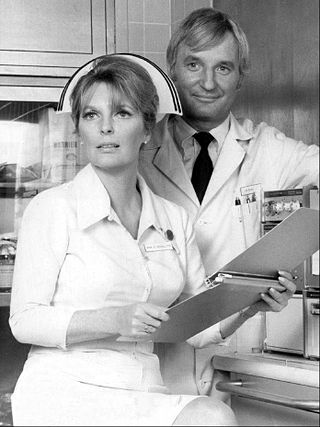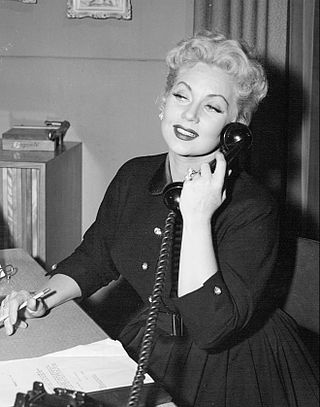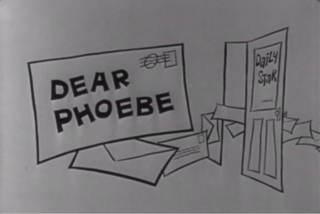Related Research Articles
The year 1958 in television involved some significant events. Below is a list of television-related events during 1958.
The year 1957 in television involved some significant events. Below is a list of television-related events during 1957.
The year 1955 in television involved some significant events. Below is a list of television-related events during 1955.

Władziu Valentino Liberace was an American pianist, singer, and actor. He was born in Wisconsin to parents of Italian and Polish origin and enjoyed a career spanning four decades of concerts, recordings, television, motion pictures, and endorsements. At the height of his fame from the 1950s to 1970s, he was the highest-paid entertainer in the world with established concert residencies in Las Vegas and an international touring schedule. He embraced a lifestyle of flamboyant excess both on and off stage.

Frankie Laine was an American singer and songwriter whose career spanned nearly 75 years, from his first concerts in 1930 with a marathon dance company to his final performance of "That's My Desire" in 2005. Often billed as "America's Number One Song Stylist", his other nicknames include "Mr. Rhythm", "Old Leather Lungs", and "Mr. Steel Tonsils". His hits included "That's My Desire", "That Lucky Old Sun", "Mule Train", "Jezebel", "High Noon", "I Believe", "Hey Joe!", "The Kid's Last Fight", "Cool Water", "Rawhide", and "You Gave Me a Mountain".
In the U.S. television industry, 100 episodes is the traditional threshold for a television series to enter syndicated reruns. One hundred episodes are advantageous for stripped syndication because it allows for 20 weeks of weekday reruns without repeating an episode, and such shows can be sold for higher per-episode pricing.

Robert William Troup Jr. was an American actor, jazz pianist, singer, and songwriter. He wrote the song "Route 66" and acted in the role of Dr. Joe Early with his wife Julie London in the television program Emergency! in the 1970s.

Metro-Goldwyn-Mayer Television, is the television studio arm of American media company Metro-Goldwyn-Mayer (MGM) specializing in broadcast syndication and the production and distribution of television shows and miniseries.
NBCUniversal Syndication Studios, formerly known as NBCUniversal Television Distribution, Universal Domestic Television, Studios USA Television Distribution and MCA TV, is the television syndication division of NBCUniversal, a division of Comcast, in the United States. Its predecessors include NBC Enterprises, Universal Television Distribution, Multimedia Entertainment, PolyGram Television, and Sky Vision. At some point in its history, it was also known as "NBCUniversal Television & New Media Distribution" and "NBC Universal Television and New Media Distribution.” This unit is possibly the parent for the similarly named "NBCUniversal Domestic Television Distribution" unit.

Private Secretary is an American sitcom that aired on CBS from February 1, 1953, to March 17, 1957. Created by Ned Marin, the series stars Ann Sothern as Susan Camille "Susie" MacNamara, devoted secretary to handsome talent agent Peter Sands, played by Don Porter.

Shower of Stars is an American anthology variety television series broadcast live in the United States from 1954 to 1958 by CBS. The series was broadcast in color which was a departure from the usual CBS programming practices of the 1950s.
Racket Squad is an American TV crime drama series that aired from 1951 to 1953.

The Frank Sinatra Show is an American television musical variety series hosted by Frank Sinatra from October 7, 1950, to April 1, 1952. The series aired on CBS on Saturdays the first season and on Tuesdays for the second year. As with many variety shows of the time, the show was broadcast live and was recorded via kinescope. Some episodes were 30 minutes long while others lasted for 60 minutes. At least one episode aired in a 45-minute time-slot.

TV Reader's Digest is the title of a 30-minute American television anthology drama series, which aired on ABC from January 17, 1955, to July 9, 1956. Its theme music was "Polonaise" from Act III of Eugene Onegin.
Official Detective is an American anthology television series which aired in syndication from 1957 to March 19, 1958. The series was hosted by veteran film actor Everett Sloane.
Combat Sergeant is an American television program that originally aired on ABC from June 29, 1956, to September 27, 1956.
The Star and the Story is an American television anthology series which aired 1955–1956 in first-run syndication. A filmed half-hour series, episodes were approximately 25 minutes long, excluding commercials.

Dear Phoebe is an American situation comedy about a male former college professor who poses as an elderly woman to write a newspaper advice column. It aired on NBC from September 1954 to April 1955. The series stars Peter Lawford and Marcia Henderson.
The Woolworth Hour is an American radio program of concert music that was broadcast on CBS from June 5, 1955, until December 29, 1957. Beginning on September 4, 1955, it was also carried on 47 stations on the Dominion Network in Canada.
References
- 1 2 Terrace, Vincent (January 10, 2014). Encyclopedia of Television Shows, 1925 through 2010, 2d ed. McFarland. p. 363. ISBN 978-0-7864-8641-0 . Retrieved March 31, 2024.
- 1 2 Brooks, Tim; Marsh, Earle F. (2009). The Complete Directory to Prime Time Network and Cable TV Shows, 1946-Present. Random House Publishing Group. p. 499. ISBN 9780307483201 . Retrieved 10 April 2018.
- ↑ "Radio-TV Guide". Jet. August 11, 1955. p. 66. Retrieved March 31, 2024.
- 1 2 "Laine Scheduled for Season on TV" . The New York Times. June 30, 1956. p. 37. Retrieved March 30, 2024.
- ↑ "CBS-TV Names Gottlieb To Head Daytime Shows". Broadcasting. July 18, 1955. p. 100. Retrieved March 31, 2024.
- 1 2 3 4 "Frankie Laine Time". Variety. July 27, 1955. p. 25. Retrieved March 31, 2024.
- ↑ "News - Possibilities - Comment". Ross Reports. July 4, 1956. p. 1. Retrieved March 31, 2024.
- 1 2 3 4 "Frankie Laine Time". Broadcasting. August 6, 1956. p. 14. Retrieved March 31, 2024.
- ↑ "Other Net Changes & Additions". Ross Reports. August 1, 1955. p. 1. Retrieved March 31, 2024.
- ↑ "The Frankie Laine Show - 1954 episode". 2 June 2018 – via Internet Archive.
- 1 2 "Frankie Laine Time". Variety. August 8, 1956. p. 29. Retrieved March 31, 2024.
- 1 2 "'Frankie Laine Time' Returns to C. B. S." . The New York Times. August 2, 1956. p. 49. Retrieved March 30, 2024.